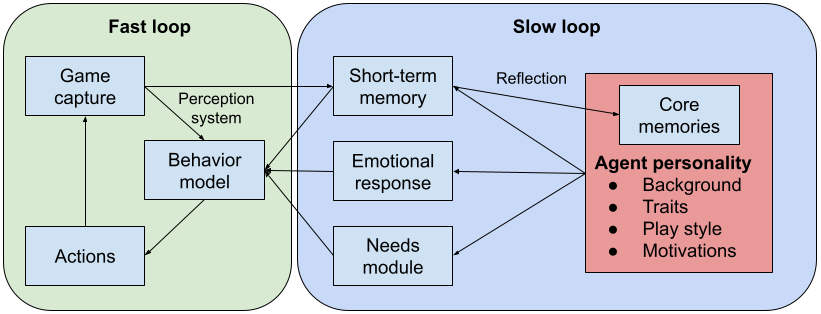Behavior is all you need
Aug 2025
Authors:
- Vishnu Hari
- Connor Brennan
Abstract
Introduction
Humans make multiplayer games compelling because of unpredictability and emotionally meaningful choices. By contrast, most bots are deterministic, stateless, and emotionally flat. The whitepaper observes that players don't need literal minds from NPCs—they need behavior that suggests intention. Much like audiences invest in fictional characters, players will suspend disbelief when agents act with coherent motivations and emotional modulation.
Framework in Brief
The paper proposes a practical behavioral stack that yields believable agents without requiring full cognitive realism.
Personality
Long-term tendencies and style. Personality shapes how an agent interprets events and chooses among plausible actions so behavior feels consistent over time.
Needs
Explicit drives (e.g., belonging, curiosity, success) create immediate motivation and make behavior legible to players.
Emotion
Transient affect that modulates decisions and responses to praise, conflict, risk, and reward— crucial for making agents feel alive.
Memory
Short- and long-term memory preserve context and growth, preventing stateless resets that break believability.
System Architecture
A lightweight, interpretable controller surrounds a language model core. Modules inject state (personality, needs, emotion, memory) and the agent acts via a tool/action interface bound to world state.

Control loop
- Sense world + retrieve relevant memory
- Condition policy on personality, needs, and emotion
- Select action via tools or language; update internal state
Tool/action interface
Grounded actions and tool calls enable coherent non-language behavior alongside dialogue.
Data collection and model path
With sufficient high-quality gameplay data, the controller can be consolidated into an end-to-end foundation model that internalizes these dynamics. Training blends supervised behavioral cloning, RLHF, self-play, and simulated data bootstrapping.
Evaluation: Embodied Turing Test
The paper proposes a multiplayer deception task where humans attempt to identify AI-controlled players using linguistic, strategic, and movement cues. Success is defined by near-chance human detection, alongside secondary metrics like role alignment, strategic diversity, and adaptive style shifts.
Applications and benefits
- More authentic gameplay and emergent social dynamics
- Automatic population of worlds with believable agents
- Automated play/balance testing and QA at scale
Limitations and future work
- Latency and cost constraints for real-time control
- Alignment of personality/needs with game design intent
- Memory scaling and privacy considerations
Conclusion
The core insight is pragmatic: agents do not need true minds to feel human—they need consistently motivated, emotionally expressive behavior. By centering design on the appearance of intention and continuity, we unlock richer gameplay, emergent social dynamics, and scalable world population.
For the full details, see the original whitepaper: Behavior is all you need